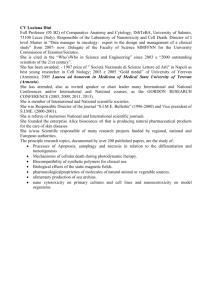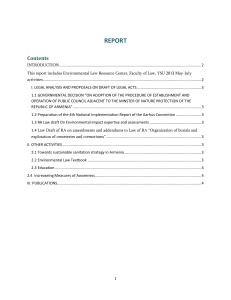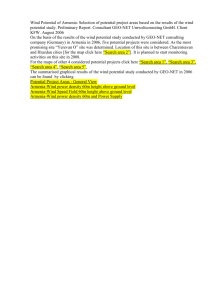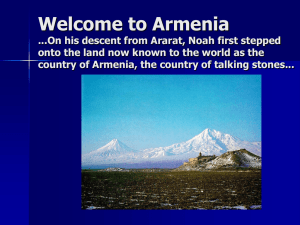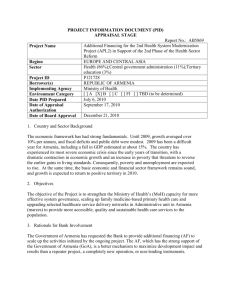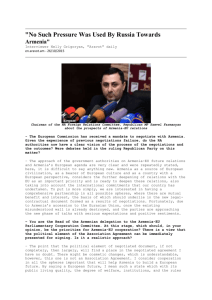National Targets and Vision for Protected Areas
advertisement
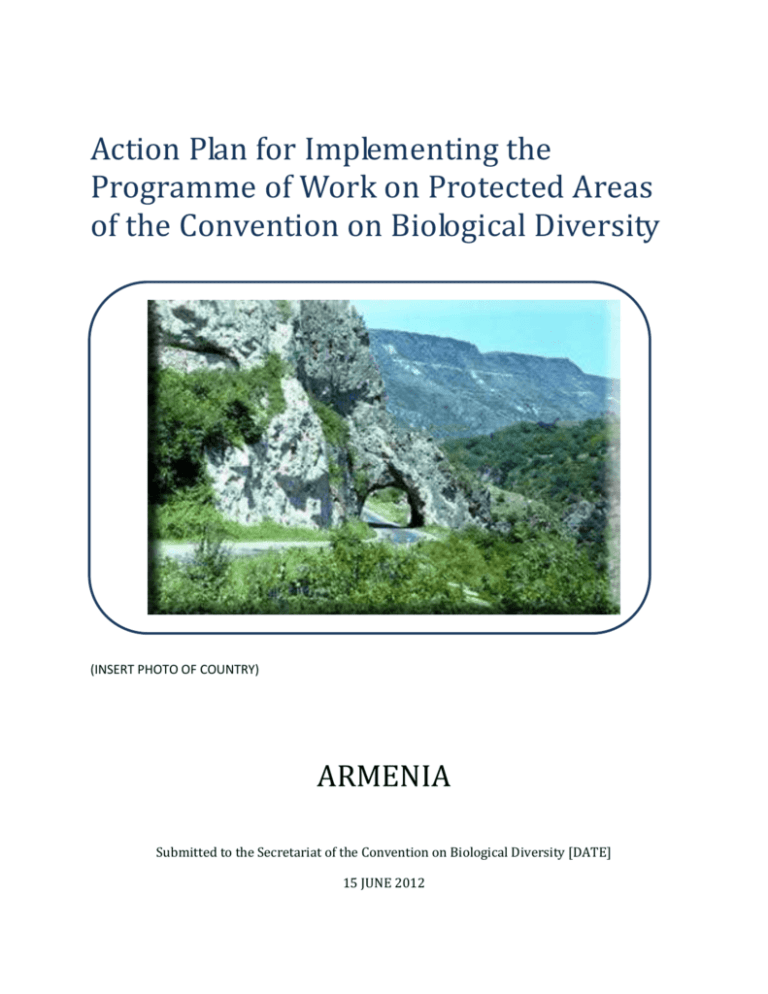
Action Plan for Implementing the Programme of Work on Protected Areas of the Convention on Biological Diversity (INSERT PHOTO OF COUNTRY) ARMENIA Submitted to the Secretariat of the Convention on Biological Diversity [DATE] 15 JUNE 2012 Protected area information: PoWPA Focal Point: (Name, contact details) Lead implementing agency: (Add name of primary government agency) Ministry of Nature Protection of the Republic of Armenia Bioresources Management Agency Multi-stakeholder committee: (Add description) Description of protected area system Coverage (Amount and % protected for terrestrial and marine; maps of protected area system) The Law of the Republic of Armenia “On Specially Protected Nature Territories” was adopted in Armenia in 2006 to provide the legal basis of the state policies for the normal development, rehabilitation, conservation and utilization of the specially protected natural areas as eco-systems of primary ecological, social, economic, scientific, historic and cultural value, of natural complexes and individual facilities. According to the effective legislation of the country, the state owned reserves, national parks state-owned reservations and natural monuments are considered ‘guaranteed specially protected nature areas’. 54 % of such areas (if without the surface of Lake Sevan, then 91%) are occupied by forest ecosystems. The system of specially protected nature areas includes the following: three state-owned reserves (Khosrov Forest, Shikahogh and Erebuni); 4 national parks(Dilijan, Lake Sevan, Lake Arpi and Arevik); 26 state-owned reservations; 230 natural monument (of them are 109 geological, 48 hydrogeological , 38 hydrological, 16 natural-historical and 19 biological). The current system of protected areas in the Republic of Armenia Number Surface (in hectares) % of the total territory of the Republic of Armenia State- owned reserves 3 36104 1.21 % National parks 4 240867 8.09% State-owned reservations 26 102216 3.44 % Natural monuments 230 N/A - 379187 12.74 % Type Total From 2005 activities aimed at revision and accurate definition of boundaries and mapping of protected areas have been funded from the state budget. The total volume of all works, including newly established natural monuments is planned for up to the year 2016. The exact surface covered by protected areas is not precise since the boundaries were not delineated. Description and background (Summary description) The Republic of Armenia covers a territory of 29.743 square kilometers. Maximum extension of its territory from north to south-east is 360 kilometers, and from west to east 200 kilometers. Around 4.8 percent of the country’s territory is covered by lakes, mainly the surface of the Lake Sevan. Armenia is a mountainous country with complicated geological composition and diverse landscape. Around 76.5 percent of the country’s territory is located at an altitude of 1000-2500 meters above sea level. The minimum altitude is 375 meters above sea level. The maximum altitude is 4095 meters at the summit of Mount Aragats. Existence of various altitudes is an important factor for the climate and the formation of vertical landscape zones. The landscape diversity in Armenia and the peculiarity of its terrain represent a critical factor for the formation and evolvement of the flora and fauna in the country. As compared to a great number of nontropical countries, Armenia is distinguished for the peculiarity and wealth of its biodiversity. In a relatively small territory grows around 3600 species of vessel plants, more than 4700 species of mushrooms, 520 species of vertebrates and around 17000 species of invertebrates, many of which are endemic. All the main natural ecosystems are represented on the territory of Armenia, with the exception of the humid sub-tropical zones. The Republic of Armenia located in the Caucasian region of Eurasia. For its exceptionally rich biodiversity, the Caucasian region has been listed by the World Wildlife Fund WWF) as one of the 200 eco-regions of the planet that have global significance. Another organization, Conservation International, has recognized the region as an endangered area and has included it in the List of Threatened Territories. Armenia is a globally important center for the evolvement of agricultural biodiversity because many wild relatives of crops and domestic animals have sustained here. Armenia’s biodiversity is extremely rich in economically valuable species. There are approximately 2,000 valuable species of plants, with characteristics ranging from nutritive and curative properties, to fodder or the production of oil, honey and resin. Animals are also economically valuable for their fur and meat. For the purpose of effective organization of biodiversity conservation process, a comprehensive study of the country’s flora and fauna was carried out in 2007-2011 with the assessment of the status of the species in conformance with international standards and republication of the Red Book of the Republic of Armenia.The Red Book was approved by the government of the Republic of Armenia in 2010 acquiring a legal status. Now the Red Book comprises 452 plant species (i.e. 12.5% of the total flora) and 308 animal species (i.e.nearly 2% of the total fauna), the status of which raises major concern. As an implement of biodiversity protection of higher efficiency, there have been created and are continuously being created specially protected natural areas within the republic. The formation of the current system of specially protected natural areas started around 1958. The process of establishment of new protected areas is underway. Following the inventory-taking and investigation of the more valuable areas in the Republic of Armenia, in 2009-2010 two national parks (Lake Arpi and Arevik) and two state-owned reservations (Zangezur and Zikatar) were created in Armenia in conformance with different resolutions of the Armenian government. The list of Armenia's natural monuments was ratified in 2008 comprising 230 facilities of nature. The list is not complete and will be continually supplemented with new monuments following respective studies. The specially protected natural areas are responsible for the conservation of around 70% of the country’s flora and fauna. 54 % of such areas (if without the surface of Lake Sevan, then 91%) are occupied by forest ecosystems, as well as wetlands. Governance types (Summary matrix of governance types) According to the Law on “Specially Protected Natural Areas”, the land of protected areas of international and national importance is exclusively state property, while protected areas of local importance could be situated on the land of the local communities as well. According to the same Law, protected areas of international and national importance should be exclusively managed by the responsible authority, which is the Ministry of Nature Protection. In fact it is not so and the Ministry of Nature Protection is responsible for all 3 state reserves, 4 national parks and only 11 sanctuaries. A number of protected arreas are under responsibility of other organizations: 14 state sanctuarys are managed by the “Hayantar” state non-trade organization of the Ministry of Agriculture, and 1 state sanctuary is managed by the Institute of Physics of the Ministry of Economy. The same situation is with all 230 natural monuments. It is expected that the situation with the land property and management authority of natural monuments will be dissolved during 2012 and2014-2016, when the boundries will be delineated. Protected area management currently is implementing through appropriate state non-commercial organizations (SNCO). The SNCOs are managed by the founder, the Government of Armenia, by the designated authority, the Ministry of Nature Protection, and by the Director of SNCO. According to the “Law on Specially Protected Natural Areas”, the responsibilities that are delegated to the regional state management authorities in the field of protected area conservation and use are following: participation in protected area state program and management plan development, and assistance to protected area conservation. Furthermore, the President Decree NP-728 of 06 May 1997 “About State Management in the Provinces” declares that the marzpets (heads of regional state management authorities) are in charge to assist with measures and action against poaching, illegal fishery and logging within the territories of state reserves, state reservations (sanctuaries), other specially protected areas. In reality such assistance is restricted to advice in protected area state program and management plan development. There are no mechanisms that regulate such relations. The responsibilities that are delegated to the regional state management authorities in the field of protected area conservation and use are fixed in the “Law on Local Self-governance” and in the “Law on Specially Protected Natural Areas”. Local Self-administration Bodies have larger responsibilities than marzpetaran: participation in protected area state program and management plan development, assistance to protected area conservation, submission of propositions to administrative authority on protected area establishment on their territories, submission of propositions on management plan development organisation of conservation, use, monitoring and scientific research, provision of important information to administrative authority, assistance to development and implementation of projects on environmental public awareness and education. It is important to mention that till now no any local protected area was established. The reasons are absence of appropriate administrative structures and specialists in place and lack of information. Key threats (Description of key threats, and maps, if available) The main threats to the protected areas are: Threat 1. Poor social conditions of neighboring community population of PAs threaten PAs ecosystems and biodiversity. The inhabitants, violating PAs regime, illegally use PAs natural resources: wood, fish resources and pastures strengthening human effect on areas. Resources overuse in PAs (animal hunting, fishery, woodcutting, haying, plant gathering) is the most important threat. There has been no attempt to re-orient (re-organize) the destructive use of resources by the population into beneficial community managed PAs. Threat 2. Mining industry developing in the country and its infrastructures may become potential threats especially for newly establishing PAs, when economic and environmental profit distribution takes place, without the exact knowledge of the biodiversity components, and their economic value apart from mining. Threat 3. Intensification of natural disasters, such as floods, mudflows, droughts, landslides and earthquakes, in most cases as a result of anthropogenic influence and human interventions, such as over-felling of forests, soil erosion, land degradation and desertification, unregulated use of water resources. Threat 4. Lack of permanent monitoring in PAs prevents from providing information about changes and responding operatively to these changes by authorities. Threat 5. Lack of tourist infrastructures endangers the PAs, since unregulated tourism occurs. It not only is a threat for PAs but also prevents them form potential outcomes that could be earned by PAs from tourism. Threat 6. Low awareness on PA functions, activities and objectives among the population and unsatisfactory level of ecological education, particularly in the communities adjacent to PAs. This endangers proper operation of PAs and the maintaining their operational Barriers for effective implementation (Description of key barrier s for effective implementation) Barrier 1. Lack of fine-scale data on ecosystem distribution other than forests. Various organizations have carried out scientific studies of different components of biodiversity both in the system of specially protected areas and out of it. However, so far state inventory of biodiversity has not been implemented and regular monitoring in PAs is not done. The lack of up-to-date information on biodiversity in PAs creates obstacles to effective management of PAs and purpose-oriented implementation of protection measures. Barrier 2. Absence of cooperation mechanisms of PAs, local communities and private sector does not support their involvement in PAs activities, as well as their participation in decision-making process. Although the RA Law on Specially Protected Nature Areas sets forth the possibility of PAs management by local communities, this form of management is still not operational due to low awareness of local communities about its importance and benefit for the communities. Barrier 3. Insufficient law enforcement, lacking by-laws and regulations to make law work in practice. This, in turn, is conditional on lack of workable tested models, poor human capacities and sometimes financial resources. There is no sufficiently qualified law enforcement staff in the PAs. Often they have no enough knowledge on related legislation, as well as they are underpaid. There is significant need for PAs staff training. Barrier 4. Absence of inter-sectoral agreed policy. During years the extensive development of industry, agriculture and forest exploitation has been given first priority in the country, whereas ecological issues have been of secondary importance. At present the importance of ecological issues is not fully acknowledged at different levels. As a result in the development strategies of different sectors (for example, city planning, agriculture, etc.) the environmental/PAs issues are not appropriately considered, which causes obstacles to regular functioning of PAs and limits their development. Barrier 5. Lack of qualified staff due to the lack of relevant training materials, training courses and curricula. The PAs staff (including management staff) needs retraining and enhanced qualification especially in the fields of use of modern methodologies on biodiversity research, inventory and monitoring, ecotourism development, introduction of new forms of management, efficient collaboration with the public and others. National Targets and Vision for Protected Areas (Insert national targets for protected areas/Target 11 of the Aichi Targets. Include rationale from protected area gap assessment, if completed, along with any additional information about the vision for the protected area system, including statements about the value of the protected area system to the country) Three strategic documents of primary importance have been developed in Armenia for the resolution of the problems in the area of PA. Those documents are: the “Second National Environmental Action Programme” approved by the government of the Republic of Armenia in 2008, “Biodiversity Strategy and Action Plan for Armenia” (1999) and “National Strategy and Action Plan for the Development of Specially Protected Nature Territories” (2002). In 2009 the Armenian government approved a program aimed at capacity building within the management system of the PA, through which: the “National Action Plan and Strategies for the Development of Specially Protected Natural Areas of Armenia” will be completed., in order to improve the strategic activities and their implementation mechanisms for the PA in Armenia; Currently Armenia is developing a new draft of the Law “On PA” and after that new by-laws will be created; The coordinated management council will be created; PA’s staffing capacity needs assessment should be implemented; Unified system of biodiversty monitoring and and cadastre must be established; Unified information PA network must be established; The projects for sustainable finance and development will be developed, and etc. Progress in and plans for achieving the goals of the Programme of Work on Protected Areas Progress: 0 = no work, 1 = just started, 2 = partially complete, 3 = nearly complete, 4 = complete Goals of the Programme of Work on Protected Areas Progress in establishing and strengthening national and regional systems of protected areas (1.1) Progress in integrating protected areas into broader land- and seascapes and sectors so as to maintain ecological structure and function (1.2) Progress in establishing and strengthening regional networks, transboundary protected areas (TBPAs) and collaboration between neighbouring protected areas across national boundaries (1.3) Progress in substantially improving site-based protected area planning and management (1.4) Progress in preventing and mitigating the negative impacts of key threats to protected areas (1.5) Progress in promoting equity and benefit-sharing (2.1) Progress in assessing and implementing diverse protected area governance types (2.1) Progress in enhancing and securing involvement of indigenous and local communities and relevant stakeholders (2.2) Progress in providing an enabling policy, institutional and socio-economic environment for protected areas (3.1) Progress in assessing the contribution of protected areas to local and national economies (3.1) Progress in building capacity for the planning, establishment and management of protected areas (3.2) Progress in developing, applying and transferring appropriate technologies for protected areas (3.3) Progress in ensuring financial sustainability of protected areas and national and regional systems of protected areas (3.4) Progress in strengthening communication, education and public awareness (3.5) Progress in developing and adopting minimum standards and best practices for national and regional protected area systems (4.1) Progress in evaluating and improving the effectiveness of protected areas management (4.2) Progress in assessing and monitoring protected area status and trends (4.3) Progress in ensuring that scientific knowledge contributes to the establishment and effectiveness of protected areas and protected area systems (4.4) Progress in marine protected areas Progress in incorporating climate change aspects into protected areas Progress 0-4 3 0 2-3 2 2 0 1 1 3 2 1 1 3 2 3 2 3 0 1 1.1 The formation of the current system of specially protected natural areas started around 1958. The process of establishment of new protected areas is underway. Following the inventory-taking and investigation of the more valuable areas in the Republic of Armenia, in 2009-2010 two national parks (Lake Arpi and Arevik) and two state-owned reservations (Zangezur and Zikatar) were created in Armenia in conformance with different resolutions of the Armenian government. The list of Armenia's natural monuments was ratified in 2008 comprising 230 facilities of nature. The list is not complete and will be continually supplemented with new monuments following respective studies. Two new specially protected natural territories,namely “Khustup” and “Gnishik” reserves planed to create. 1.3 One transboundary protected area (Lake Arpi) was established with Georgia and one planed to create with Iran. 1.4 The government of the Republic of Armenia approved the management plans for “Dilijan” national park (2007), “Sevan” national park (2007), “Khosrov Forest” state-owned reserve (2009) and «Lake Arpi» national park (2011). The draft version of the management plan for «Shikahogh» state-owned reserve has been developed also. 1.5 Currently Armenia is developing a new draft of the Law “On PA”. In the course of the development of management plans for all state-owned areas an inventory taking of natural resources has been carried out, the primary factors disturbing the balance of ecosystems have been identified, the criteria for environmental various impacts of economic operations have been determined and the methods for the forecast of various development tendencies of the ecosystem status have been developed. In addition, tourism and recreation development scenarios have been discussed; items of natural and cultural legacy have been inventoried. There is an imperative need for ensuring the development process of management plans for the wildlife reservations with consideration of their current status, identification of needs and requirements, clarification of borders and prescription of concrete actions; Professional training sessions are periodically organized at the Ministry of Nature Protection for the inspectors; Reforestation activities are currently carried out in devastated and disorganized areas. Particularly, activities to build a new forest shelter belt around Lake Sevan are underway and will be completed in September 2011. ……….. 2.1 ……….. Priority activities for fully implementing the Programme of Work on Protected Areas: Activities 1. Develop Site-level management plans for state-owned reservations 2. To fulfill the list of natural monuments and to develop and approve their passports 3. Establishment of unified system of biodiversty monitoring and cadastre 4. Establishment of national ecological network of protected areas (Insert more as needed) Timeline 2020 2016 2020 2012 Action Plans (detailed steps) for completing priority activities for fully implementing the Programme of Work on Protected Areas: Activity 1: 1 Develop Site-level management plans for state-owned reservations/ sanctuaries Key steps Develop the regulations for state-owned reservations Identification of needs and requirements Clarification of borders Prescription of concrete actions Development of site management plans and present to confirmation by government of RA Timeline 2020 Responsible agencies Ministry of Nature Protection of the Republic of Armenia Indicative budget No data Bioresources Management Agency Activity 2: To fulfill the list of natural monuments and to develop and approve their passports Key steps To fulfill the list of natural monuments of Lori and Tavush marzes and to develop and approve their passports To fulfill the list of natural monuments of Syniq, Armavir marzes and Yerevan city and to develop and approve their passports To fulfill the list of natural monuments of Aragatsotn, Vayots Dzor and Shirak marzes and to develop and approve their passports To fulfill the list of natural monuments of Gegharquni, Kotayq and Ararat marzes and to develop and approve their passports Timeline 2012 Responsible agencies Ministry of Nature Protection Indicative budget 10 mln AMD State budget 2014 No data (not confirmed) 2015 No data (not confirmed) 2016 No data (not confirmed) Activity 3: Establishment of unified system of biodiversty monitoring and cadastre Key steps Establishment of unified system of biodiversty monitoring and cadastre (Insert more as needed) Timeline 2020 Responsible agencies Ministry of Nature Protection of RA Indicative budget No data Activity 4: Establishment of national ecological network of protected areas Key steps Establishment of national ecological network of protected areas Timeline 2012 Responsible agencies Ministry of Nature Protection of RA Indicative budget 0.5 mln.USD GEF 5 Key assessment results Ecological gap assessment (insert summary findings if available) Management effectiveness assessment (Insert summary findings if available) Sustainable finance assessment (Insert summary findings if available) Capacity needs assessment (Insert summary findings if available) Policy environment assessment (Insert summary findings if available) Protected area integration and mainstreaming assessment (Insert summary findings if available) Protected area valuation assessment (Insert summary findings if available) Climate change resilience and adaptation assessment (Insert summary findings if available) (Insert other assessment results if available)
